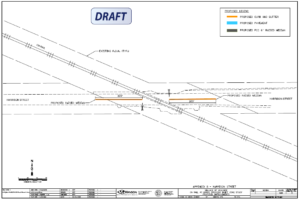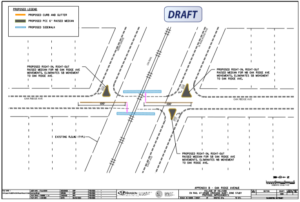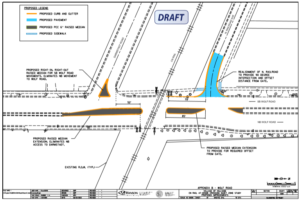Quiet Zone Train Horn Information
The locomotive horn is an effective deterrent to accidents at grade crossings. However, the sound level from the locomotive horn creates a significant noise that often depreciates the quality of life in communities where trains operate. The Federal Railroad Administration (FRA), on June 24, 2005, issued its Final Train Horn Rule that allows Public Authorities to establish Quiet Zones where locomotive horns are not routinely sounded at the public grade crossings. The result may be improved living conditions as loud train horns are silenced.
The Federal Railroad Administration (FRA) has sanctioned the installation of Quiet Zones where the locomotive horn is not sounded and where Supplemental Safety Measures (safety enhancement options) compensate for the absence of the train horn. The locomotive engineer is required to desist from sounding the conventional train horn if one safety option is installed. The FRA sanctioned Supplemental Safety Measures (SSMs) that allow the silencing of the locomotive horn include the following:
- Median barriers or channelization devices in combination with two-quadrant gates
- Four-quadrant gates
- Crossing closure (either permanent or temporary during night hours)
- Paired one-way streets with full closure gates
Draft Plans
Recent News and Updates
Updated Response: View the most recent response to questions about local quiet train horn crossings (PDF).
Public Meeting Notice: A public meeting was held on Saturday, March 3rd at 10:00 AM at the Hillside School, 4804 West Harrison Street.
Letter to Residents: View letter sent to residents (PDF).
Quiet Zone Process: View the Quiet Zone process.
Guidelines: View guidelines for Quiet Zones by the FRA under Appendix C to Part 222.
Requirements: The FRA requirements and standards for Railroads can be found here (view link).
Hanson Professional Services Inc. had no involvement with / in regards to Elmhurst Quiet Zones thus; we are unable to comment or provide any information on what was done to achieve them.
Please note that every crossing is viewed differently and uniquely by the FRA, ICC, IDOT, Railroad Owners, and Counties.
Cost: View Project Cost Estimate (PDF) *More details regarding the cost estimate will be provided during the meeting on March 3rd. The previous estimate posted was conceptual and created prior to meeting with the FRA. It was revised per the requirements indicated during the FRA field meeting.
Frequently Asked Questions
What is the history of quiet train crossings in Elmhurst?
- The Village discussed the Quiet Zones with representatives of the Elmhurst.
- The zones were established under a DuPage County program. Several Villages were involved in the program.
- The project occurred over multiple years and completed in May 2006.
- The FRA Final Rule on Quiet Zones took effect August 2006 which stipulates: “FRA is making a minor revision to the definition of “channelization device” in the Final Rule. FRA revised this definition in the Final Rule to prohibit the use of surface-mounted tubular markers and vertical panels within quiet zones as SSMs, where the surface mounted tubular markers or vertical panels are not used in conjunction with a raised longitudinal channelizer.”
- Surface mounted tubular delineators (like Elmhurst) are no longer permitted by the FRA as of August 2006.
What are the current cost estimates for these projects?
The website contains the most current version of the cost estimate. Please note that is it subject to change per additional work required by the ICC, IDOT, CN, Cook County, and FRA during the NOI review and hearing.
What are the actual, legal, guidelines for train engineers to blow/sound the horn prior to the (street) crossing?
The FRA Train Horn Rule says:
- The minimum sound level of the locomotive horn is 96 decibels (dBA) 100 feet in front of the train in its direction of travel, and
- The maximum is 110 dBA at 100 feet in front of the train in its direction of travel.
- Also, the locomotive horn must be sounded 15 to 20 seconds prior to and until the train arrives at the crossing. The locomotive horn should not be sounded greater than ¼ mile in advance of a grade crossing.
Could the village or Hanson Engineering obtain a report on train-car-pedestrian accidents from the NTSB for the last 10-20 years?
A request has been placed for the accident information. Hanson Professional Services Inc. cannot guarantee that the information exists on file with the NTSB.



